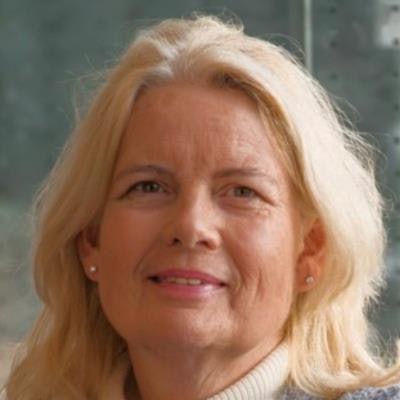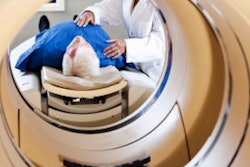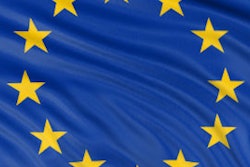
The European imaging community has praised the remarkable career achievements and scientific legacy of Prof. Marion Hendriks-de Jong, professor of preclinical nuclear medicine and head of the Translational Molecular Imaging and Therapy research group at Erasmus MC, Rotterdam, the Netherlands.
"Many of us have lost a good friend, collaborator, mentor, and bright scientist," Prof. Freek Beekman, head of the biomedical imaging section at Delft University of Technology and CEO and founder of MILabs, told AuntMinnieEurope.com. "Marion was already suffering from cancer for about 15 years, but kept going to perform intense research on this same disease, with a strong focus on radionuclide therapy and imaging (theranostics)."
 "Love your youngsters in the team," said Marion Hendriks-de Jong. Photo courtesy of Prof. Freek Beekman.
"Love your youngsters in the team," said Marion Hendriks-de Jong. Photo courtesy of Prof. Freek Beekman."Her contribution to the field was transformative," noted her Erasmus MC in memoriam for staff. "She always knew how to inspire and encourage her colleagues. She had an enormous network, many of whom she became friends with and always supported wholeheartedly. Her sincere, caring and warm personality made her an easy person to talk to and confide in, not only about work-related aspects but also on a personal level.
"For many of us, Marion was more than a promotor, supervisor and colleague, she was also a mother-figure and a friend. She took all of her team members under her wing and guided them through whatever scientific hurdles came along, by sharing her network, knowledge, and experience," the obituary stated.
According to a statement issued by the European Society for Molecular Imaging (ESMI), "Marion was a brilliant scientist whose work had a great impact on cancer care. Her strong, engaging yet always kind and gentle personality often came along with a wonderful sense of humour. Marion was a mentor, role model, and just brilliant in building collaborative bridges between disciplines and generations. It was such a pleasure and privilege to know and work with her."
In a European Association of Nuclear Medicine (EANM) message, EANM President Dr. Jolanta Kunikowska, PhD, praised Hendriks-de Jong's "indescribable dedication" and said, "You will continue to inspire us and will always have a special place in our hearts. You will never be forgotten!"
Therapy for Steve Jobs and others
Hendriks-de Jong studied biology and biochemistry at Wageningen University and joined Erasmus MC in 1985 as a doctoral student, focusing on tumor imaging and radionuclide therapy and working with Prof. Dr. Eric P. Krenning.
"They were extremely successful together. Within this collaboration, Marion is credited for inventive contributions to the launch of lutetium-177 (Lu-177) oxodotreotide (Lutathera), the first Food and Drug Administration and European Medicines Agency approved peptide receptor radionuclide therapy (PRRT) to combat neuroendocrine tumors (NETs)," noted Beekman. "Even Steve Jobs (of Apple) flew over to Erasmus to try this therapy, but he came at too late a stage."
Along with the physics and imaging research and development teams at TU-Delft and MlLabs, Hendriks-de Jong and Beekman collaborated on finding ways to image therapeutic isotopes like bismuth-213 -- one of the most frequently used α-emitters in cancer research -- with a Versatile Emission Computed Tomography system (VECTor) for radionuclides that enables simultaneous submillimeter imaging of single-photon and positron-emitting radiolabeled molecules.
"Due to the high gamma energies, these isotopes could not be imaged with traditional preclinical SPECT," he explained. "The joint paper our teams wrote in the Journal of Nuclear Medicine inspired many researchers around the globe to use clustered pinhole technology to develop new theranostics in oncological mouse models. She was driving the biological side and was always great at keeping everyone's feet on the ground."
She was "one of the trailblazers in theragnostic imaging," Beekman added.
Blood, sweat, and tears
Hendriks-de Jong became a professor at Erasmus MC in 2007 and won numerous awards during her career, including the EANM Marie Curie award, the Association of Imaging Producers & Equipment Suppliers (AIPES) Press and Media Award, and the 2021 MILabs Research Achievement Award.
"Multidisciplinary work in this field is key and this might mean blood, sweat, and tears, but also you will certainly have big fun together. This is because of the very good collaborations that can be built in the field with added value for all partners, both researchers in academic centers and industry," she said in a Q&A interview with MILabs.
"Go for new developments; there are so many opportunities ahead, theranostics are the future. Also, invest and love your youngsters in the team; education is an important part of the research."
Right up to her death, she worked on the introduction of several new and exciting tracers and expanded her team's work on combination therapies such as epigenetic drugs and immunotherapies. Also, she collaborated with research groups in the Applied Molecular Imaging at Erasmus MC (AIMIE) Core Facility, in the Medical Delta with Delft and Leiden University, and in Nijmegen, Athens, Montpellier, and the U.S. and with multiple industry partners, including with Novartis/AAA and MILabs.
"Preclinical and clinical molecular imaging will continue to play an important role in the preclinical evaluation of these radiotracers as well as in the (back)translational studies that we perform to bring new compounds and techniques into the clinic to improve current compounds and techniques already clinically applied," Hendriks-de Jong commented.
She was the promotor of over 50 doctoral students and author of more than 450 peer-reviewed journal articles, and she served on multiple international committees and boards. At Erasmus MC, Hendriks-de Jong was involved in the creation of a program especially for talented women, and she was involved in setting up an EANM international program for women.
She was a great mentor for many scientists and leaves behind a legacy of passionate scientific pursuit, Beekman added.
Her husband and the love of her life, Jan Hendriks, passed away suddenly in November 2019. They had three sons and a granddaughter, of whom she was immensely proud. She was passionate about, and extremely talented in, nature photography, particularly birds.
"Marion was a very creative and talented person," noted the Erasmus MC in memoriam. "She also loved to tell stories during lunch breaks with a touch of humor, about her past experiences at meetings and conferences, which we enjoyed thoroughly. Marion always took part in social activities and games full of dedication, and a lot of enthusiasm. It was good to have her on your team. She had an impact on all of us and on our lives ... great and small."
"With a lot of respect and admiration, we will remember her enormous strength and resilience, especially in the past years," the obituary stated.



















